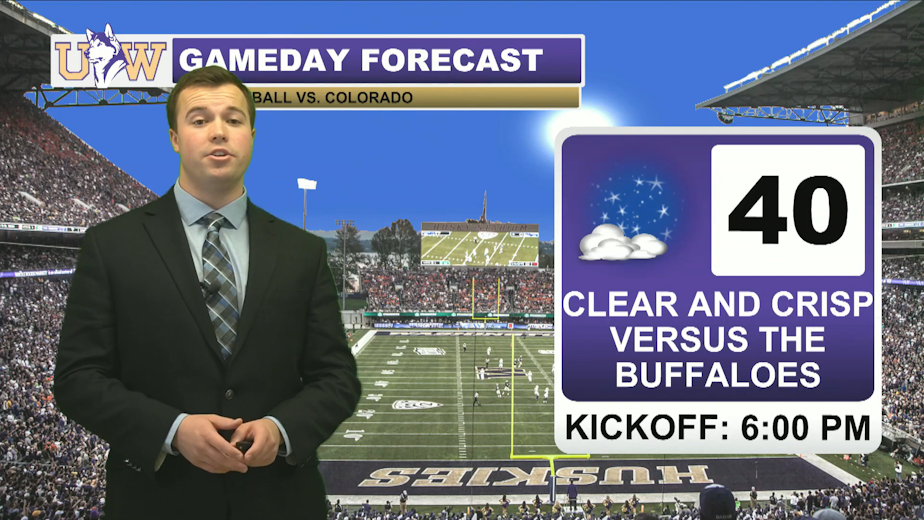From upper-level troughs to omega blocks, UW students learn to talk about the weather

Students in the University of Washington Broadcast Meteorology club and class have a love of weather and take on the difficult task of communicating it clearly.
In some circles talking about the weather is considered a very plain topic.
There are however, people out there who love talking about the weather. A group of them meet every Friday at the University of Washington Atmospheric Sciences Building, and learn about weather from KOMO TV chief meteorologist Shannon O'Donnell.
Each week, the group posts blogs and YouTube weather forecasts. They call it the DawgCast.
On a Friday afternoon in mid-October, the class discusses the weather of the last week. It's been unseasonably hot, with temperatures in the upper 80s. It's been smokey. Today is the first day of measurable rain in months.
The weather has been challenging records, but how to talk about the upcoming weather won't be challenging at all.
Sponsored
"We get these days where it rains one minute, then it's sunny, and it rains and then it's sunny," O'Donnell says. "So one of the ways forecasters here have learned to communicate that is a 'showers and sunbreaks' sort of day."
O'Donnell advises the broadcast meteorology club at the University of Washington. She also teaches a class on the subject in winter quarter.
At the club meeting, O'Donnell goes through all the work students have done over the last week – blog posts, tweets, and TV-style forecasts.
She shows off a myriad of weather forecasting sites to students. She walks through different models.
O'Donnell's love for weather comes from watching Midwestern storms roll in at her grandparent’s house long after her siblings went inside.
Sponsored
She graduated from the University of Washington and worked as a broadcaster in the Bay Area before joining KOMO-TV in Seattle.
At KOMO, O'Donnell worked under the long tenured weather forecaster Steve Pool.
"I was his weather assistant when I was a UW student," O'Donnell says, "and he'd always sit down with me and we'd go through the forecast. And he'd say, 'OK, give me something pithy.'"
Anyone can see the weather on their phone, so O'Donnell teaches her students to talk about the weather in an interesting and fun way, to imbue delivering the temperature with personality.
It’s not always easy. Some students are communications majors, others are in the hard sciences, and some don’t even have a major that has to do with weather at all.
Sponsored
They're all here because, like O'Donnell, they saw some weather event and they fell in love, and that love led to them to this classroom.
During the club, students build graphics about the weather today. The class debates whether “clear” gets the point across about the end of the smoke. Does it imply that it’s sunny, too?
The class settles on “clean” instead.
There’s also the wall, where students give a TV-style weather forecast in front of a green screen. Shannon calls on club president Anthony Edwards, who wears a suit and tie.
Edwards takes a big gulp of water, emphatically plops his water bottle down on a table, and delivers today’s weather.
Sponsored
Communication has changed over the last decade. Weather forecasters are expected to marry the pithy with the reality of climate change.
Talking about the weather is usually a safe topic. These days with differing perspectives, it isn’t that simple.
Forecasters have to take this on. Talking about climate change is a new challenge. Hearing from climate change deniers and deciding what to do about that is another new challenge.
Sponsored
Edwards tweeted about late season forest fires and connected them to climate change. It had about 1,000 retweets and a number of climate change denying comments in the thread. It's something O'Donnell advises her class on.
Social media also has its upsides and is a major part of the class. O'Donnell says students can connect with their audience and hone their personality.
Personality shows up a lot in the UW DawgCast Club.
"For a third-grade science project, I made a Doppler radar out of play dough. Like, I don't know, why I did that. But that's something that I did," student Olivia Lee says.
Taking complex ideas and distilling them down to something understandable is difficult. It’s something Lee experienced in the third grade and now.
"Sometimes people don't understand what an upper-level trough means," she says. "I'll say things like that and you have to think about is it accessible for people to like, understand those things?"
Anthony Edwards says it’s not just about complexity. It’s something people have always been mad at meteorologists for: a wrong forecast.
"It's kind of like somebody who's a stock analyst trying to analyze the market," Edwards says, "and if they're wrong they'll take heat for it, and so, it's the same with like meteorology."
Of course, no one can predict the future. At the beginning of the club meeting, O'Donnell goes through her methods for forecasting the weather. She talks about where we’ve been, where we are, and where we’re going.
Most students talk about the where we’re going in their forecasts, too. And even after the DawgCast is over, they keep on forecasting on Twitter and the DawgCast blog.
Looking to the future is something O'Donnell is doing with these students, too. Her favorite part of teaching is guiding students to their next steps like grad school or the National Weather Service or small market TV stations. Places where they can continue talking about the things they love.





